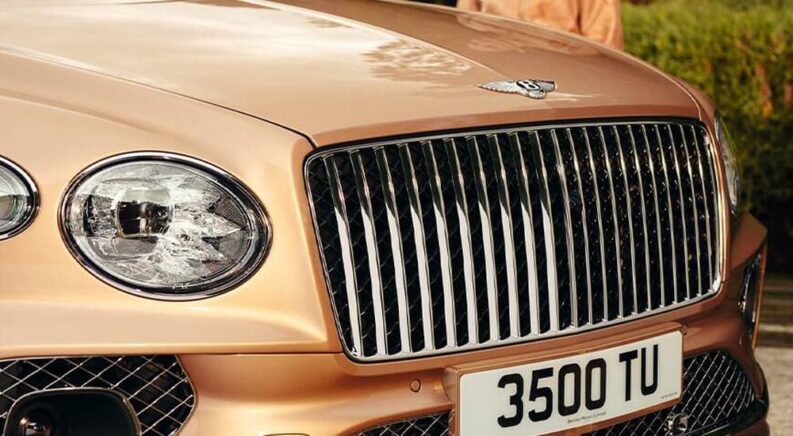Above a certain price point, a vehicle is more than just a way to get around: it’s a work of art. While the definition of “art” is largely in the eye of the beholder, Bentley’s range of luxury vehicles certainly qualifies from a price perspective. With the most affordable model ringing in at around $200,000 and collectible models going for as much as $7 million, a Bentley costs about as much as a lower-end painting from Picasso. But how does the British automaker justify such high prices? In a word, craftsmanship. Whether you’re talking about the entry-level Bentayga or a bespoke Batur, each Bentley is a one-of-a-kind work of automotive art that’s built from start to finish by some of the finest artisans in the business.
Hand-Built Automobiles
While the average vehicle is constructed in around 18 to 35 hours on an automated assembly line, Bentley moves at a comparably glacial pace, hand-building every car. A Bentley Continental GT, for example, takes over 100 hours to assemble, while a Bentayga takes over 130 hours. In fact, it took Bentley over 100 years to produce as many cars as Toyota does in any given week, an arresting statistic that goes to show just how much time and effort is put into every Bentley model.
However, while scarcity plays a role in the high price of a Bentley, attention to detail and premium materials costs also have a significant impact. “Materials are the most exciting leap in the evolution of car design, together with using the latest technologies to execute them in a way that has never been seen before,” says Brett Boydell, Bentley’s head of interior design studio. “New materials are breathing new life into the interior and exterior of cars and the way we do things.”
From ancient stone and exotic wood to copper, leather, and the most British of fabrics, tweed, Bentley has built its reputation by sourcing unique, premium materials that allow each vehicle to showcase the best in automotive craftsmanship. Join us as we take a closer look at just what goes into a Bentley and see how the brand sets itself apart through the use of high-end luxury materials.

Exotic Wood
The use of wood as an interior accent is a longstanding tradition in the automotive world, but Bentley takes the practice to another level entirely. The automaker offers many different types of wood veneer using exotic timber options that range from Dark Stained Burr Walnut to more modern, minimalist options like Hawaiian Koa. For the recent EXP 100 GT concept car, Bentley even partnered with specialists to source fossilized oak from peat bogs where it had lain for centuries.
The story of the brand’s Liquid Amber veneer provides an interesting look into the automaker’s exhaustive selection process. In a bid to offer something truly unique, Bentley spent two years on research before trekking off to the Mississippi wetlands in a search for the American red gum tree. Every board is ethically sourced, but Bentley takes this commitment to sustainability to the next level by only selecting timber that has fallen naturally and replacing it with a new tree.
Bentley has its own in-house woodshop in Crewe to ensure the highest possible level of craftsmanship, curing every panel for 72 hours and then sanding and lacquering it five times until it meets the brand’s exacting standards. One aspect that really sets the Bentley interior apart is the use of mirror-matching. In order to ensure a sense of continuity across the cabin, Bentley uses the mirror-matching technique to join together sheets of veneer from the same tree. This approach results in a seamless grain pattern that encircles the entire cabin, tying the interior together in a way that few other automakers can hope to match.
Custom Paint
Nothing says luxury quite like customization, and when it comes to personalizing your Bentley, the brand has drivers covered. Bentley offers more standard color options than any other automaker, including solid, metallic, pearlescent, and satin options. If the offered colors leave something to be desired, have no fear. Bentley has a longstanding relationship with Mulliner, the world’s oldest coachbuilder, whose craftsmen are adept at making each vehicle a one-of-a-kind automotive masterpiece. Simply send the Mulliner team a sample of your favorite color, and the company will use digital color matching to replicate it throughout the vehicle. This extends not only to the exterior but even to the upholstery, stitching, and various interior flourishes; the team can even hand-paint desired accents.
Once the color is selected, a team of experienced artisans gets to work painting each vehicle. While the automaker does use machines and robotics in some aspects of its operation, the work is still completely largely by hand, with a team of painters taking hours to sand, paint, and polish every car. On some higher-end models, this process can take as long as five days as each Bentley is dip-cleaned and electro-coated with primers before being sprayed with a coat of color. After being cured in an oven, the body is sanded and then hit with a clear coat before being polished once again. The process is repeated until the paint has almost a mirror finish, with craftspeople using 600-grit sandpaper to ensure the ultimate shine.
Luxurious Fabric
Leather has long been synonymous with luxury, so it probably doesn’t come as much of a surprise that every Bentley is packed chock-full of the stuff. Bentley doesn’t use any plastic or faux leather in any of its vehicles and sources leather from some of the finest tanneries around the world, ensuring that every Bentley has a soft, supple interior worthy of its refined design and engineering.
Bentley doesn’t skimp, using as many as 15 hides for a single vehicle. The Bentley Flying Spur, for example, uses 13 hides throughout the cabin, which take 26 hours to cut, stitch and apply to the interior surfaces. Of course, even the best materials don’t amount to much if they’re not properly installed, which is why Bentley employs some of the finest artisans in the business to kit out its vehicles. The 120-person needlecraft team at Bentley’s facility in Crewe has decades of experience in leatherwork, sharing best practices and training new workers to ensure the highest possible level of institutional knowledge.
Much of this work is completed by hand, which is one of the reasons it can take so long. Take the steering wheel of the Bentley Mulsanne, for example. The rounded design would present some problems for a machine but is well within the capabilities of Bentley’s experienced staff. The process of wrapping the steering wheel in leather can take as long as five hours, with over 30 feet of thread being used to complete 620 individual stitches. While that amount of attention to detail might seem excessive, it’s just a small part of the interior, which, in total, can take as much as 136 hours to complete.
While leather is the most popular choice for Bentley drivers, the brand stays true to its roots with the recent introduction of a new, thoroughly British option: tweed. Sourced from Scotland’s renowned Lovat Mill in Hawick, the environmentally-friendly tweed is produced using renewable energy and no hazardous chemicals. The tweed trim comes in four colors––Cheltenham, Glen Plaid-Tolsta Beach, Charcoal, and Sand Herringbone––allowing every Bentley driver to make sure their car’s interior matches their Sunday best.
Classic Stone
We’ve covered paint, upholstery, and wood veneers, so what is left? Stone, of course. Bentley is always on the lookout for ways to set its vehicles apart and certainly accomplished that goal with a recent effort to introduce new stone veneers into the catalog of customization options. These sustainably sourced stone veneers come from all across the world and are cured using glass fiber and resin before being shipped to Bentley’s factory. Once there, the stone is laser-cut to a thin sheet, allowing it to be applied throughout the cabin without adding any unnecessary bulk or weight.
The centuries-old bog-sourced wood veneers might be impressive, but it’s nothing compared to the stone, which has typically been waiting some 200 million years to find a new home in a high-end luxury vehicle from Bentley. The brand has used its expertise to work the stone veneers in new and innovative ways. It has even experimented with using copper to add a metallic accent to the surface. The stone veneers are offered as an optional add-on by Bentley, so while they might not grace every model, they serve as a prime example of the company’s willingness to explore the unknown and stay ahead of the game in the ultra-competitive luxury segment.
Doing Things the Old-Fashioned Way
There’s no questioning Bentley’s engineering prowess, but the brand has really set itself apart through its use of premium materials. A vehicle’s interior gives designers a chance to really up the luxury factor, flexing their creative muscle and sourcing some of the best, most rarefied materials from all over the world. From fossilized wood and ancient stone to some of the world’s best leather and tweed to innovative paint options, Bentley makes it exceedingly easy to craft an artful ride that’s sure to turn heads. It’s easy to question where all the money is going in some luxury models, but Bentley is a notable exception, pouring its century of experience into crafting some of the most opulent vehicles on the road today. While automation has become the name of the game for so many players in the automotive sphere, it’s good to know that some brands are still content to do things the old-fashioned way.





